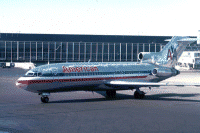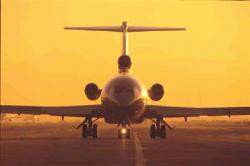Wed, May 01, 2002
 American Airlines ran its final Boeing 727
passenger flight yesterday, marking the retirement of an airline
industry workhorse by its largest operator. American operated the
biggest 727 fleet, at one time flying 182 of the tri-jets.
American Airlines ran its final Boeing 727
passenger flight yesterday, marking the retirement of an airline
industry workhorse by its largest operator. American operated the
biggest 727 fleet, at one time flying 182 of the tri-jets.
American employees, customers and reporters gathered Tuesday
evening at Miami International Airport terminal B to watch the
final four 727 flights from Miami, which were all scheduled to
depart Miami between 7:10 p.m. and 7:30 p.m. EDT. The last 727
departure from Miami was AA flight 926 to Raleigh/Durham, which
received a traditional water cannon retirement salute on taxi-out.
Passengers on flight 926 received certificates commemorating their
historic final 727 flight on American.
 The
727 was significant to the development of today's air
transportation system. The earliest model 727s entered service in
1964, helping bring the first pure jet service to many smaller
communities. A unique high-lift wing design, its rakish "T-Tail,"
and three powerful aft-mounted turbofan engines allowed the 727 to
economically serve airports too small for the larger first-
generation jetliners, like the four-engine Boeing 707 and Douglas
DC-8. There were 1,832 Boeing 727s produced -- a production run
surpassed only by the nearly 4000 Boeing 737s built thus far.
The
727 was significant to the development of today's air
transportation system. The earliest model 727s entered service in
1964, helping bring the first pure jet service to many smaller
communities. A unique high-lift wing design, its rakish "T-Tail,"
and three powerful aft-mounted turbofan engines allowed the 727 to
economically serve airports too small for the larger first-
generation jetliners, like the four-engine Boeing 707 and Douglas
DC-8. There were 1,832 Boeing 727s produced -- a production run
surpassed only by the nearly 4000 Boeing 737s built thus far.
"The popular Boeing 727 is a landmark aircraft design, often called
'The DC-3 of the Jet Age' because of its versatility and
performance," said Gerard Arpey, American's president and chief
operating officer. "The 727 served American's customers dependably
and comfortably throughout our system for many years. We salute the
retiring 727 for its contribution to American's success."
American is replacing its 727s with a newer Boeing -- the 737-800
twin- jet. This "New Generation" 737-800 flies approximately the
same number of passengers farther and higher, yet consumes about 60
percent less fuel per passenger than the 727 tri-jet it replaces.
The 727 is the last aircraft in American's fleet to require a
three-person flight crew. Automation on newer airliners replaced
the necessity for the flight engineer position.
American Airlines 727 Facts
At its peak, AA operated 182 Boeing 727s -- the largest fleet of
727s in the world.
AA introduced its first early model 727 in 1964 (long since
retired) and was among the first 727 operators.
 AA
operated two models of the 727: the original shorter 727-100,
configured for 118 passengers in two classes when it retired in
1994; and the "stretch" 727-200, currently configured for 138
passengers in two classes.
AA
operated two models of the 727: the original shorter 727-100,
configured for 118 passengers in two classes when it retired in
1994; and the "stretch" 727-200, currently configured for 138
passengers in two classes.
AA's 727-200 is being replaced by new, twin-engine Boeing 737-800,
that can fly approximately the same number of passengers farther,
more quietly and burn much less fuel. For example, the 737-800
burns about 60 percent fewer gallons of fuel per passenger per hour
than the 727.
727 is AA's last three-engine airplane, its last three-person
cockpit airplane, and the only aircraft AA operated that was fitted
with "hush- kits" to meet noise standards. All AA jets today have
two engines. None requires a flight engineer on the crew. And all
meet stricter noise standards without hush-kits.
 727
was revolutionary, "the DC-3 of the Jet Age." It was the industry
workhorse for years, flying AA and the industry to
deregulation.
727
was revolutionary, "the DC-3 of the Jet Age." It was the industry
workhorse for years, flying AA and the industry to
deregulation.
727 brought economical jet service to smaller communities for the
first time, thanks to its ability to use shorter runways than
first-generation jetliners, like the larger 707 and DC8.
727 allowed American to become an all-turbine airline in 1966 (pure
jets & turboprops), and all pure jet in 1969.
The 727 was versatile. AA's shortest scheduled 727 flight was
Boston-Providence, at 49 miles; longest was Chicago-Los Angeles, at
1,744 miles.
The last original --100 model of the 727 retired from AA in 1994.
All remaining 727s are the -- 200 "stretch" models.
AA has eight 727s remaining in service, all retiring from passenger
service April 30.
TWA retired its last 727 in 2000, operating a maximum fleet of 100
727s.
More News
Severe Icing The rate of ice accumulation is such that ice protection systems fail to remove the accumulation of ice and ice accumulates in locations not normally prone to icing, s>[...]
“...The Airmen that work on the flight line can turn around to the shelf, grab the part, put it in the airplane, and now it’s going to perhaps be several more days befo>[...]
Aero Linx: Alaskan Aviation Safety Foundation (AASF) Welcome to the Alaskan Aviation Safety Foundation. The foundation was created to improve aviation safety in Alaska through educ>[...]
From 2022 (YouTube Edition): Jenny, I’ve Got Your Number... Among the magnificent antique aircraft on display at EAA’s AirVenture 2022 was a 1918 Curtiss Jenny painstak>[...]
Mid-Continent Instruments and Avionics and True Blue Power ANN's NBAA 2025 Coverage... Visit Them At Booth #3436 101 Aviation Nears STC Approval for Lithium Battery Upgrade on Gulf>[...]
 ANN's Daily Aero-Term (10.14.25): Severe Icing
ANN's Daily Aero-Term (10.14.25): Severe Icing Aero-News: Quote of the Day (10.14.25)
Aero-News: Quote of the Day (10.14.25) ANN's Daily Aero-Linx (10.14.25)
ANN's Daily Aero-Linx (10.14.25) Classic Aero-TV: Curtiss Jenny Build Wows AirVenture Crowds
Classic Aero-TV: Curtiss Jenny Build Wows AirVenture Crowds True Blue Power and Mid-Continent Instruments and Avionics Power NBAA25 Coverage
True Blue Power and Mid-Continent Instruments and Avionics Power NBAA25 Coverage




